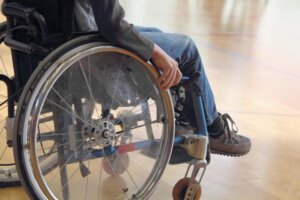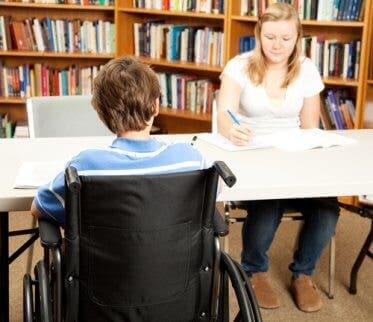Educational Intervention for Children with Motor Disabilities


Written and verified by the psychologist Ana Couñago
In an inclusive school, an attempt is made to provide equal education to all types of students, including children with motor disabilities. For this reason, we prepared this article on educational intervention in children with motor disabilities.
These types of students have certain specific educational support needs that the school must effectively address.
Educational needs of children with motor disabilities
Children with motor disabilities have psychomotor development problems and, generally, may also have speech and language development disorders. These disabilities affect various areas of their life, such as:
- The learning process.
- The exhibition of sensorimotor experiences.
- Interaction and relationships with other people.
- The perception of themselves and the environment.
Because of this, these students have a series of educational needs that require special attention. Thus, depending on the level of help and attention they require, a student with this disability can enroll in:
- An ordinary school. If the school has enough resources to meet the child’s needs.
- A special education center. When they require specific support due to a higher level of affectation.
- In both modalities. This way, they enjoy the advantages of both an ordinary school and a special education center.

Educational intervention for children with motor disabilities
At school, teachers have an obligation to adapt to children with motor disabilities. Thus, they must adjust the educational response to their needs. For this, it’s convenient for the teacher to:
- Have knowledge of motor disabilities and their learning consequences.
- Use methodologies to support inclusion.
- Accept the guidance of support teachers and adapt to the use of specific materials and the presence of adapted furniture.
- Communicate fluently with parents to learn about the family environment and report on the educational process and the various adaptations set in place.
Specialist support teacher
But a good intervention requires support teaching staff. Thus, children with motor disabilities need a physical therapist at school to get relevant evaluations and physical rehabilitation sessions. Likewise, the physical therapist must:
- Guide other professionals about the correct postural guidelines when doing school activities.
- Take care of furniture and materials adaptations.
On the other hand, normally, these children require hearing and language teachers to mitigate the language problems that children with motor disabilities can present. These specialists must evaluate and develop these student’s communication skills.
Another support teacher involved in the education of these children is the therapeutic pedagogue, whose role is to provide precise educational support to achieve programmed school goals. In addition, they must:
- Participate in the evaluation process.
- Prepare adapted teaching materials.
- Carry out the curriculum adaptations along with the tutoring teachers and the other professionals of the team.
- Collaborate with the classroom tutor in family relationships.
Finally, we should note that, in many cases, children with motor disabilities require the assistance of an educational support specialist. Their main goal is to help the child with the basic needs that they can’t do on their own. Therefore, they can help them with:
- Displacement and mobility.
- Getting dressed and undressed.
- Feeding.
- Personal hygiene.
- Sphincter control.
- Participation in group games.
Physical adaptations at school
In addition, for a correct educational intervention of children with motor disabilities, it’s essential to mention the physical adaptations the school must have in order to respond to these students’ difficulties. Thus, we can highlight the existence of:
- An accessible entrance to the school (wide, with a ramp, non-slip floors, etc.).
- Rounded handrails in hallways and on stairs.
- An elevator.
- Physiotherapy room.
- Adapted bathrooms.
- A large classroom that’s accessible for walkers and wheelchairs.
As for furniture adaptations, they vary depending on the child’s difficulties. Some of the most common are:
- Padded headrests on chairs.
- Armrests.
- Footrests.
- Seat tilt adjustment.
- Table with cut-out.
- Sloping table.
- Plaster casts placed on the chair.
- Standing frames.
In an inclusive school, an attempt is made to provide equal education to all types of students, including children with motor disabilities. For this reason, we prepared this article on educational intervention in children with motor disabilities.
These types of students have certain specific educational support needs that the school must effectively address.
Educational needs of children with motor disabilities
Children with motor disabilities have psychomotor development problems and, generally, may also have speech and language development disorders. These disabilities affect various areas of their life, such as:
- The learning process.
- The exhibition of sensorimotor experiences.
- Interaction and relationships with other people.
- The perception of themselves and the environment.
Because of this, these students have a series of educational needs that require special attention. Thus, depending on the level of help and attention they require, a student with this disability can enroll in:
- An ordinary school. If the school has enough resources to meet the child’s needs.
- A special education center. When they require specific support due to a higher level of affectation.
- In both modalities. This way, they enjoy the advantages of both an ordinary school and a special education center.

Educational intervention for children with motor disabilities
At school, teachers have an obligation to adapt to children with motor disabilities. Thus, they must adjust the educational response to their needs. For this, it’s convenient for the teacher to:
- Have knowledge of motor disabilities and their learning consequences.
- Use methodologies to support inclusion.
- Accept the guidance of support teachers and adapt to the use of specific materials and the presence of adapted furniture.
- Communicate fluently with parents to learn about the family environment and report on the educational process and the various adaptations set in place.
Specialist support teacher
But a good intervention requires support teaching staff. Thus, children with motor disabilities need a physical therapist at school to get relevant evaluations and physical rehabilitation sessions. Likewise, the physical therapist must:
- Guide other professionals about the correct postural guidelines when doing school activities.
- Take care of furniture and materials adaptations.
On the other hand, normally, these children require hearing and language teachers to mitigate the language problems that children with motor disabilities can present. These specialists must evaluate and develop these student’s communication skills.
Another support teacher involved in the education of these children is the therapeutic pedagogue, whose role is to provide precise educational support to achieve programmed school goals. In addition, they must:
- Participate in the evaluation process.
- Prepare adapted teaching materials.
- Carry out the curriculum adaptations along with the tutoring teachers and the other professionals of the team.
- Collaborate with the classroom tutor in family relationships.
Finally, we should note that, in many cases, children with motor disabilities require the assistance of an educational support specialist. Their main goal is to help the child with the basic needs that they can’t do on their own. Therefore, they can help them with:
- Displacement and mobility.
- Getting dressed and undressed.
- Feeding.
- Personal hygiene.
- Sphincter control.
- Participation in group games.
Physical adaptations at school
In addition, for a correct educational intervention of children with motor disabilities, it’s essential to mention the physical adaptations the school must have in order to respond to these students’ difficulties. Thus, we can highlight the existence of:
- An accessible entrance to the school (wide, with a ramp, non-slip floors, etc.).
- Rounded handrails in hallways and on stairs.
- An elevator.
- Physiotherapy room.
- Adapted bathrooms.
- A large classroom that’s accessible for walkers and wheelchairs.
As for furniture adaptations, they vary depending on the child’s difficulties. Some of the most common are:
- Padded headrests on chairs.
- Armrests.
- Footrests.
- Seat tilt adjustment.
- Table with cut-out.
- Sloping table.
- Plaster casts placed on the chair.
- Standing frames.
All cited sources were thoroughly reviewed by our team to ensure their quality, reliability, currency, and validity. The bibliography of this article was considered reliable and of academic or scientific accuracy.
- Basil, C. (2012). Los alumnos con parálisis cerebral y otras alteraciones motrices. En Á. Marchesi, J. P. González y C. Coll (Ed.), Desarrollo Psicológico Y Educación: 3. Trastornos Del Desarrollo Y Necesidades Educativas Especiales (pp. 303-328). Madrid: Alianza Editorial.
- Martínez, M. D., Sanciñena, M. J., Sánchez, M., Sánchez, C. y Yoldi, S. (2000). Necesidades Educativas Especiales: Alumnado con Discapacidad Motórica. Navarra: Centro de Recursos de Educación Especial de Navarra (CREENA).
This text is provided for informational purposes only and does not replace consultation with a professional. If in doubt, consult your specialist.








